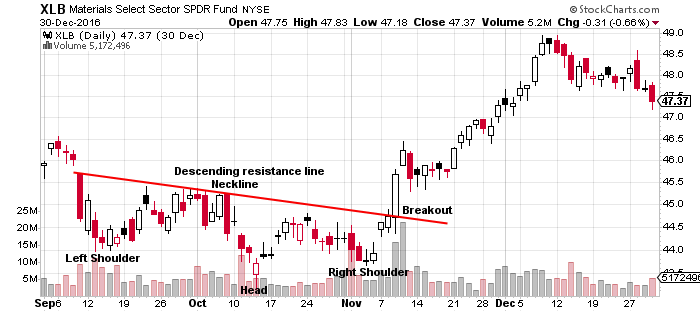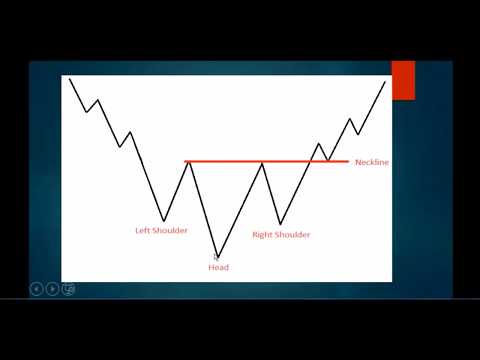While the Head and Shoulders Chart Pattern is one of the most popular in Technical Analysis few people have heard of the Inverted Head and Shoulders Pattern. It is basically the opposite of the classic Head and Shoulders, while the regular pattern is ominous and bearish the inverted version of the pattern is very bullish as it plays out and a chart makes its price bottom.
Chart Facts:
- This pattern is called the reverse or inverse Head and Shoulders chart pattern or a Head and Shoulders bottom and is a reversal pattern of a downtrend. The pattern is formed during a bear market or downtrend and the completion of this pattern is bullish and is usually a set up for a new uptrend to begin or a bull market. A previous downtrend must be in place before this pattern can be considered valid.
- This pattern can form many times near a bottom in a downtrend.
- This pattern consists of three valleys with the middle lower valley creating the ‘head’ and each smaller valley is a ‘shoulder’. The high for the peaks between the valleys is used to create the horizontal resistance which is the ‘neckline’.
- The break of the neckline resistance to the upside is the signal line to buy.
- The left shoulder is created during the first swing down. Price then pulls back to resistance on the upswing.
- The next down swing in price goes lower than the left shoulder and breaks down to a new lower low but eventually swings back up to near the previous resistance high in price.
- The third swing down in price is higher than the middle peak that is the head and similar in size to the first low in price that is the left shoulder. Price then swings back higher for the third time near the previous two areas of resistance.
- The three swing backs to high price resistance should be similar to create a horizontal resistance line that is the neckline in this pattern. This line can be very flat or trend up or down. A neckline that is trending up is another indicator of the end of the downtrend.
- This pattern should see declining volume to the downside of the head and shoulders and increasing volume as it swings higher after each valley to give additional signs of accumulation.
- The Inverse Head and Shoulders pattern is not confirmed until the neckline of the pattern is broken to the upside. Many times the old resistance at the neckline becomes the new support as price tries to pull back after the break out to the upside. Increasing volume on the break above the neckline is more confirmation of the potential for an uptrend.
- The magnitude of the move up can many times be the same magnitude as the distance from the neckline to the bottom of the head in the Inverted Head and Shoulders pattern.
This $XLB chart shows an Inverse Head and Shoulders pattern forming before the 2016 U.S. presidential elections after a downtrend in price. The head is lower than both shoulders with the right shoulder being lower than the left shoulder and the neckline descending. There was a powerful bullish candlestick on the breakout of the neckline triggering a long signal that ran from $46 to $50 for a $4 gain on the move. This was a bottoming pattern that indicated a new uptrend starting with the momentum signal of the breakout and was before the next leg of the bull market kicked off in November 2016.

Chart Courtesy of StockCharts.com
Chart Summary: The Inverse Head and Shoulders pattern is created at the end of a bear market when the market exhausts sellers and each of three lows in price is met with new buying pressure and short covering. The head of the pattern generally creates a market bottom. The resistance line of the neck is where sellers step in with volume to push price down at lower prices to unload two times but not the third. The pattern can be irregular in sizes and shapes; the key is seeing the three valleys with the middle lower than the other two that are similar in size and the middle line of resistance close to each rally peak in the pattern.
Chart patterns are great technical trading tools for establishing the path of least resistance and your risk/reward ratio at entry.
